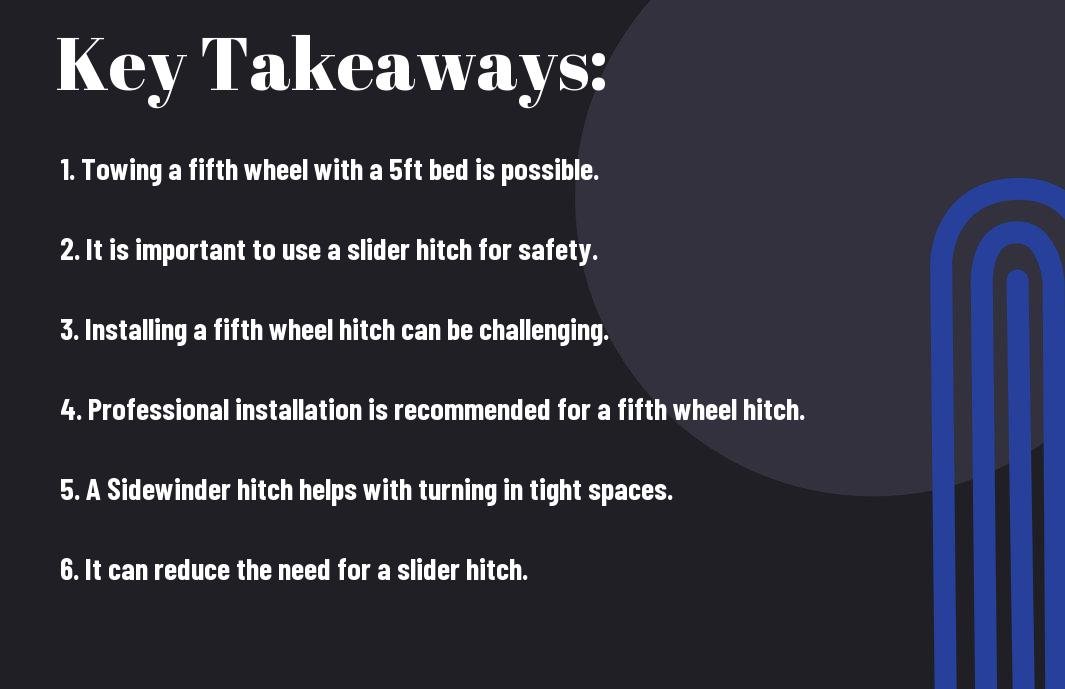You may be wondering whether it’s possible to tow a fifth wheel with a 5-foot bed. The short answer is yes, it is possible, but it requires some careful consideration and the right equipment. In this blog post, we will discuss the challenges and possibilities of towing a fifth wheel with a 5-foot bed, the difficulty level of installing a fifth wheel hitch, and the benefits of using a Sidewinder hitch. We’ll cover the potential safety issues, as well as the benefits of using the proper equipment to make towing a fifth wheel with a shorter bed a smooth and secure experience for you and your rig. Whether you’re a seasoned RVer or a newbie, this post will provide you with the essential information you need to make an informed decision on this topic.
Key Takeaways:
- Towing a Fifth Wheel with a 5 Foot Bed: It is possible to tow a fifth wheel with a 5 foot bed, however, it may require the use of a special hitch or an extended pin box to prevent contact between the truck cab and the trailer during sharp turns.
- Difficulty of Installing a Fifth Wheel Hitch: Installing a fifth wheel hitch can be a challenging task, especially for those with limited mechanical experience. It may require drilling into the truck bed and precise measurements to ensure proper alignment.
- Professional Installation: Due to the complexity of installing a fifth wheel hitch, it is often recommended to have it installed by a professional to ensure proper setup and safety.
- Benefits of a Sidewinder Hitch: A Sidewinder hitch is designed to offset the pivot point of the fifth wheel, allowing for sharper turning angles without the risk of the trailer contacting the truck cab, making it a valuable solution for towing with a 5 foot bed.
- Consideration for Maneuverability: When towing a fifth wheel with a 5 foot bed, it’s important to consider the truck’s turning radius and maneuverability in tight spaces to avoid potential issues.
- Weight Distribution and Payload Capacity: It’s crucial to ensure that the truck’s weight distribution and payload capacity are suitable for towing a fifth wheel, especially with a 5 foot bed, to avoid overloading the vehicle.
- Consulting with Experts: For individuals considering towing a fifth wheel with a 5 foot bed or installing a fifth wheel hitch, seeking advice from experienced RV professionals or mechanics can provide valuable insights and guidance.

Towing a Fifth Wheel with a 5 Foot Bed
Now, let’s talk about the feasibility of towing a fifth wheel with a 5-foot bed. This is a common concern for many truck owners who want to enjoy the convenience and comfort of towing a fifth wheel trailer with a smaller truck bed.
Feasibility and Limitations
When it comes to towing a fifth wheel with a 5-foot bed, it is important to consider the limitations and feasibility. The shorter bed length can pose some challenges when it comes to maneuverability and clearance between the truck cab and the trailer. However, with the right setup and equipment, it is possible to safely tow a fifth wheel with a 5-foot bed.
Tailoring Your Approach for Safety and Compatibility
When towing a fifth wheel with a 5-foot bed, it’s crucial to tailor your approach for safety and compatibility. You will need to invest in a sliding fifth wheel hitch that can be adjusted to provide additional clearance when making tight turns. This will help mitigate the risk of damage to the cab of your truck or the front of the trailer. Additionally, you may need to consider a Sidewinder hitch which can further enhance maneuverability and alleviate some of the challenges posed by the shorter bed length.
Installing a Fifth Wheel Hitch
To ensure a smooth and safe towing experience with your fifth wheel, it’s crucial to properly install a fifth wheel hitch to your truck. Here’s a guide on how to install a fifth wheel hitch and the tools you’ll need to get the job done.
Preparation and Tools Needed
Before you begin the installation process, it’s important to gather all the necessary tools and materials. This will ensure that the installation goes smoothly and efficiently. The tools you will need include:
| Tools | Materials |
| Wrench set | Fifth wheel hitch kit |
| Drill | Mounting hardware |
| Tape measure | Safety goggles |
| Torque wrench | Level |
Step-by-Step Hitch Installation Guide
When installing your fifth wheel hitch, it’s essential to follow a step-by-step guide to ensure that the hitch is securely and properly mounted to your truck bed. Here is a breakdown of the installation process:
| Step | Description |
| 1 | Measure the truck bed and mark the positioning for the hitch. |
| 2 | Drill holes for the mounting hardware according to the hitch manufacturer’s specifications. |
| 3 | Assemble the fifth wheel hitch according to the instructions provided with the kit. |
| 4 | Secure the hitch to the mounting brackets using the provided hardware, torque to the manufacturer’s specifications. |
Installing a fifth wheel hitch may seem like a daunting task, but with the right tools and a clear understanding of the process, you can successfully install the hitch yourself. Remember to always double-check the hitch’s installation to ensure it is secure and properly mounted to your truck bed before towing your fifth wheel.
Exploring the Sidewinder Hitch
Not all trucks are created equal, and not all fifth wheel towing setups are the same. If you have a short bed truck and want to tow a fifth wheel, the Sidewinder hitch may be the solution you’ve been looking for. This innovative hitch can make towing a fifth wheel with a 5 foot bed much easier and safer.
What is a Sidewinder Hitch?
The Sidewinder hitch is a unique towing solution designed specifically for short bed trucks. It is a king pin box that is attached to the fifth wheel trailer, allowing for a much greater turning radius than a standard hitch setup. This extra range of motion is achieved by moving the pivot point of the trailer rearward, which in turn allows you to make tight turns without worrying about the trailer hitting the cab of your truck.
Benefits and Considerations for Use with Short Bed Trucks
If you have a short bed truck, the Sidewinder hitch can provide you with greater maneuverability and peace of mind when towing a fifth wheel. It can eliminate the need for a sliding hitch, which can be cumbersome and heavy. Additionally, the Sidewinder hitch may also reduce the risk of trailer sway and improve stability while towing, making for a safer overall towing experience. However, it’s important to note that the Sidewinder hitch may have some limitations in terms of compatibility with certain fifth wheel trailer models, so be sure to do your research before making a purchase.
Conclusion
From above, you have learned that it is possible to tow a fifth wheel with a 5 foot bed, but you will need a sliding fifth wheel hitch to do so. The installation of a fifth wheel hitch can be challenging, especially if you are not experienced with working on vehicles. However, with the right tools and some patience, it can be done. Additionally, you have been introduced to the Sidewinder hitch, a specially designed hitch that allows you to tow a fifth wheel without the need for a sliding hitch. This innovative solution can make towing with a 5 foot bed much easier and more convenient. Overall, with the right equipment and know-how, you can successfully tow a fifth wheel with a 5 foot bed and enjoy all the benefits of this type of RV.
FAQ
Q: Can you tow a fifth wheel with a 5-foot bed?
A: Yes, it is possible to tow a fifth wheel with a 5-foot bed, but it requires the use of a special hitch, such as a sliding hitch or a Sidewinder hitch, to provide the necessary clearance between the trailer and the truck cab. Without a specialized hitch, the risk of the trailer hitting the cab during sharp turns is significantly higher.
Q: How hard is it to install a fifth wheel hitch?
A: The difficulty of installing a fifth wheel hitch can vary depending on the make and model of the hitch, as well as the specific vehicle it will be installed on. In general, the process can be complex and time-consuming, requiring basic mechanical skills and knowledge of the vehicle’s frame and towing capacity. It is recommended to seek professional installation to ensure safety and proper functionality.
Q: What is a Sidewinder hitch?
A: A Sidewinder hitch is a specialized type of fifth wheel hitch designed to allow for towing a fifth wheel trailer with a short bed truck, typically 5 to 6 feet in length. The Sidewinder hitch features a rotating turret that moves the pivot point of the trailer rearward, providing additional clearance between the trailer and the truck cab during sharp turns. This innovative design helps to prevent the trailer from making contact with the cab, reducing the risk of damage and improving maneuverability.
Q: Are there weight limitations for towing with a 5-foot bed?
A: Yes, when towing with a 5-foot bed, it is important to consider the weight limitations of the truck and the hitch. Exceeding these limitations can lead to unsafe towing conditions, including reduced stability, braking capacity, and control. It is crucial to adhere to the manufacturer’s recommended towing capacity and ensure the proper installation of a compatible hitch system.
Q: What are some tips for towing a fifth wheel with a short bed truck?
A: When towing a fifth wheel with a short bed truck, it is essential to use a sliding hitch or a Sidewinder hitch to provide the necessary clearance. Additionally, always ensure that the trailer is properly connected and balanced, and that all safety chains, brake systems, and lighting are in good working order. Practice maneuvering and backing up in an open, safe area to familiarize yourself with the handling and limitations of the combined vehicle and trailer. Regularly inspect and maintain the hitch, trailer, and truck to ensure safe and reliable towing.
